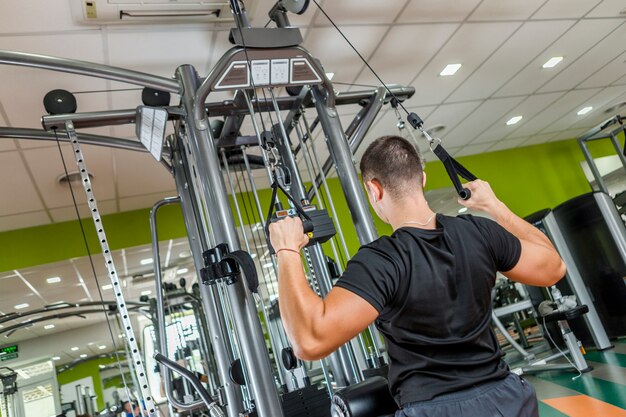Muscular strength is an essential motor ability that helps individuals overcome resistance by building muscle tension. This strength is crucial for various physical activities, from lifting heavy objects to handling everyday tasks. By understanding the factors that determine muscle strength and the best methods to develop it, people can improve their physical performance and overall health.
Determinants of Muscle Strength
Many factors influence muscle strength, some of which are fixed, while others can be improved through training.
Immutable Factors
Type of Muscle Fibers: The type of muscle fibers, such as fast-twitch and slow-twitch, affects muscle strength. Fast-twitch fibers are for short, intense exercises, while slow-twitch fibers are for endurance activities.
Pennation Angle: This is the angle at which muscle fibers align with the muscle’s line of action. A larger pennation angle can result in higher muscle force.
Tendon Insertion Point: Where the tendon attaches to the bone influences leverage and muscle force.
Kinematic Characteristics of the Joints: The structure and function of joints impact muscle force production.
Improvable Factors
Cross Section of Muscle (Hypertrophy): Muscle size, as seen in the cross-sectional area, can increase with strength training, leading to more strength.
Fiber Recruitment: Training can boost the body’s ability to activate more muscle fibers, enhancing strength.
Muscular Coordination: Better coordination within and between muscles can boost force production.
Stretching Abilities: Improved muscle flexibility through training can also improve strength.
The Three Core Types of Muscle Strength
1. Maximum Strength
Maximum strength is the peak force generated during a voluntary contraction. It’s the maximum force produced in a single effort, crucial for activities like powerlifting and weightlifting, where single, strong efforts are required.
2. Strength Endurance (Resistant Strength)
Strength endurance is the muscle’s ability to resist fatigue over prolonged, strength-demanding activities. It’s about sustaining force repeatedly at a submaximal level, important for sports like rowing, climbing, and cycling.
3. Explosive Strength (Rapid or Fast Strength)
Explosive strength involves the quick generation of force, essential for movements requiring sudden bursts of power, such as sprinting, jumping, or throwing. It’s the speed at which force is applied that defines explosive strength.
Optimizing Training for Your Strength Goal
Different types of strength require specific training tools, repetition ranges, and intensity levels.
1. Maximum Strength
Focus on compound exercises like squats, deadlifts, bench presses, and overhead presses. Proper form is vital to avoid injuries. Rest 3-5 minutes between sets for full recovery.
– Tools: Free weights (barbells, dumbbells), weight machines, resistance bands, power racks.
– Rep Range: Typically 1-6 repetitions per set.
– Intensity: Very high, around 85-100% of your one-repetition maximum (1RM).
2. Strength Endurance (Resistant Strength)
Use a mix of compound and isolation exercises. Circuit training or supersets with minimal rest (30 seconds to 1 minute) helps maintain heart rate and endurance.
– Tools: Bodyweight, free weights, resistance bands, kettlebells, medicine balls, cardio equipment.
– Rep Range: High, typically 12-20+ repetitions per set.
– Intensity: Moderate to low, around 50-70% of your 1RM.
3. Explosive Strength (Rapid or Fast Strength)
Incorporate plyometric exercises and Olympic lifts to develop fast-twitch fibers. Focus on acceleration and speed during the lifting phase. Rest 2-3 minutes between sets for full recovery.
– Tools: Plyometric equipment, medicine balls, free weights for Olympic lifts, bodyweight exercises.
– Rep Range: Typically 1-6 repetitions per set, focusing on speed and quality.
– Intensity: Moderate to high, around 50-80% of your 1RM.
Always begin with a proper warm-up and conclude with a cool-down. Adjusting training variables over time based on your progress and goals will help you achieve the best results.
Static and Dynamic Muscle Conditioning
Muscle conditioning exercises fall into static (isometric) and dynamic (non-isometric) categories, each with unique benefits for strength, endurance, and explosive strength.
Static (Isometric) Exercises
Isometric exercises involve holding muscles in a fixed position without any visible movement. Examples include planks, wall sits, and static squats, where you hold a position to increase training intensity.
Dynamic (Non-Isometric) Exercises
Dynamic exercises involve movement and changes in muscle length and joint angles. They are divided into isotonic and isokinetic exercises.
Isotonic Exercises: These involve muscle length changes against constant resistance, like lifting free weights. Examples include bicep curls and bench presses, where the muscle force varies due to changes in leverage and joint angles.
Isokinetic Exercises: These are performed at constant speeds using specialized equipment that adjusts resistance. This ensures maximum muscle engagement throughout the motion, ideal for rehabilitation and targeted strength training.
Understanding these principles can help create effective strength training programs tailored to individual needs. Always consult with a fitness professional or healthcare provider before starting a new exercise regimen.







